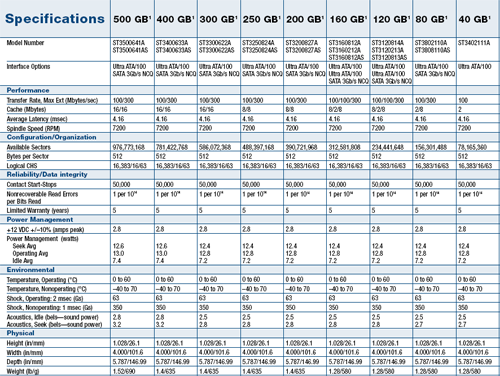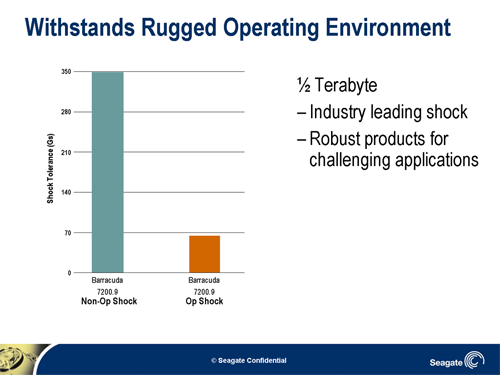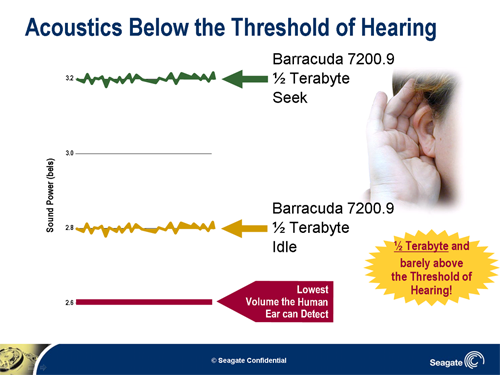Introducing Seagate's 7200.9: The New Generation
by Purav Sanghani on October 10, 2005 9:00 AM EST- Posted in
- Storage
The 7200.9 Series
On the outside, the 7200.9 drives look identical to the 7200.7 and 7200.8 series of desktop drives. On the inside, the 7200.8 line was the first to incorporate the highest density platters to date in their 400GB version drive at 133GB per platter. This puts Seagate ahead of Hitachi who released their 500GB DeskStar quite some time ago. The new 7200.9 line has incorporated a higher density 160GB platter into a few of its drives. The following screenshot shows the manufacturer's specifications for each 7200.9 drive according to capacity size.
The 160GB platter has only gone into the 80GB drive, which uses a single side and single head, and the 160GB drive, which uses both sides of the platter with 2 heads. The 400GB model still uses its original three 133GB platter design that was implemented in the 7200.8, while the new 500GB drive uses four 125GB platters. Why not just use the 160GB platters for the 500GB drive? Doing the math, 3x160GB would bring us to 480GB, which is 20GB short of the 500GB mark, and 4x160GB comes out to 640GB, which cannot be marketed at 500GB without a 140GB waste in total capacity. It makes the most sense to use 4x125GB platters to bring us to a perfect 500GB total capacity. (Note that the drive's total capacity will be slightly lower in Windows, as 1GB is 1,073,741,824 bytes for Windows, but only 1,000,000,000 bytes in hard drive manufacturer specs.)
All of the SATA 2.5 Trimmings
A few months ago, we cleared up some confusion regarding the SATA naming conventions and what they mean. The confusion was with the SATA II name being used in unison with the 3.0Gb/sec transfer rate. SATA II was actually the name of the SATA standards organization, which decides the specifications for each SATA version. (They've since changed names to SATA-IO.) At the time, many thought that the 3.0GB/sec came standard in all drives labeled as SATA II. In fact, transfer rate along with other options such as hot plug, hot swap, and NCQ are options that drive manufacturers can implement in their products if they choose. You can even get most of the "SATA II" features in "SATA I" drives.
Seagate states that it has incorporated all of the features that SATA has to offer in the 7200.9 series including the following:
In 2004, 20% of hard disk drives shipped were SATA based - about 41 million, according to Seagate Market Research. It is estimated that this year, the percentage will increase to 80% of shipped drives being SATA based, 40% of which will be Seagate drives. Meanwhile, PATA is being phased out and nearly all production will cease by the end of 2006.
Other Characteristics
Seagate reports that all of the drives in the 7200.9 line will feature an operating shock tolerance of about 63Gs and a non-operating shock of 350Gs, making them extremely rugged. Almost all but Hitachi's 7K500 drive can handle this much non-operating shock, but shock tolerance during normal operation is not as forgiving, with many drives only allowing about 55Gs. Not that we would recommend dropping your drives or computer, but accidents happen...
Seagate is also reporting a lower sound rating between 2.5-2.8 bels while the drives are idle, and about 2.8-3.2 bels while the drives are seeking for data. According to Seagate, the lowest amount of sound audible by human ears is about 2.6 bels, so the idle noise output is borderline inaudible to our ears. Combine this with the hum of case and heat sink fans, and the hard drive is basically silent.
On the outside, the 7200.9 drives look identical to the 7200.7 and 7200.8 series of desktop drives. On the inside, the 7200.8 line was the first to incorporate the highest density platters to date in their 400GB version drive at 133GB per platter. This puts Seagate ahead of Hitachi who released their 500GB DeskStar quite some time ago. The new 7200.9 line has incorporated a higher density 160GB platter into a few of its drives. The following screenshot shows the manufacturer's specifications for each 7200.9 drive according to capacity size.
The 160GB platter has only gone into the 80GB drive, which uses a single side and single head, and the 160GB drive, which uses both sides of the platter with 2 heads. The 400GB model still uses its original three 133GB platter design that was implemented in the 7200.8, while the new 500GB drive uses four 125GB platters. Why not just use the 160GB platters for the 500GB drive? Doing the math, 3x160GB would bring us to 480GB, which is 20GB short of the 500GB mark, and 4x160GB comes out to 640GB, which cannot be marketed at 500GB without a 140GB waste in total capacity. It makes the most sense to use 4x125GB platters to bring us to a perfect 500GB total capacity. (Note that the drive's total capacity will be slightly lower in Windows, as 1GB is 1,073,741,824 bytes for Windows, but only 1,000,000,000 bytes in hard drive manufacturer specs.)
All of the SATA 2.5 Trimmings
A few months ago, we cleared up some confusion regarding the SATA naming conventions and what they mean. The confusion was with the SATA II name being used in unison with the 3.0Gb/sec transfer rate. SATA II was actually the name of the SATA standards organization, which decides the specifications for each SATA version. (They've since changed names to SATA-IO.) At the time, many thought that the 3.0GB/sec came standard in all drives labeled as SATA II. In fact, transfer rate along with other options such as hot plug, hot swap, and NCQ are options that drive manufacturers can implement in their products if they choose. You can even get most of the "SATA II" features in "SATA I" drives.
Seagate states that it has incorporated all of the features that SATA has to offer in the 7200.9 series including the following:
- Hot Plug
- Hot Swap
- ClickConnect
- Native Command Queuing (NCQ)
- Staggered Spin-Up
- 3G (3.0Gb/sec, backwards compatible with 1.5Gb/sec hardware) maximum transfer rates
In 2004, 20% of hard disk drives shipped were SATA based - about 41 million, according to Seagate Market Research. It is estimated that this year, the percentage will increase to 80% of shipped drives being SATA based, 40% of which will be Seagate drives. Meanwhile, PATA is being phased out and nearly all production will cease by the end of 2006.
Other Characteristics
Seagate reports that all of the drives in the 7200.9 line will feature an operating shock tolerance of about 63Gs and a non-operating shock of 350Gs, making them extremely rugged. Almost all but Hitachi's 7K500 drive can handle this much non-operating shock, but shock tolerance during normal operation is not as forgiving, with many drives only allowing about 55Gs. Not that we would recommend dropping your drives or computer, but accidents happen...
Seagate is also reporting a lower sound rating between 2.5-2.8 bels while the drives are idle, and about 2.8-3.2 bels while the drives are seeking for data. According to Seagate, the lowest amount of sound audible by human ears is about 2.6 bels, so the idle noise output is borderline inaudible to our ears. Combine this with the hum of case and heat sink fans, and the hard drive is basically silent.
In the next few weeks we will be looking at the performance of the 500GB 16MB SATA model of the 7200.9. We'll put it through our usual synthetic, simulated, and real world tests, and we'll compare it not only to the 400GB 7200.8, but also to some older drives like the 120GB 7200.7 as well as Maxtor's and Hitachi's higher capacity drives.













72 Comments
View All Comments
Lifted - Monday, October 10, 2005 - link
Hopefully this will bring down the price of the 500GB drives a bit. Running out of space for TV shows, and I already have a couple 400's and 250. Anybody find a RAID-5 external enclosure yet that holds 3 or more drives? I've been looking for one for a while now. I'm getting nervous with all my stuff not being RAID or backed up.Visual - Monday, October 10, 2005 - link
Um, the hotplug/hotswap feature sounds interesting, is it supported on any of the integraded sata controllers? I know my nforce4 has some "safely remove hardware" icon for my drive, but im quite sure the hdd doesnt support such a maneuver. Its quite confusing...